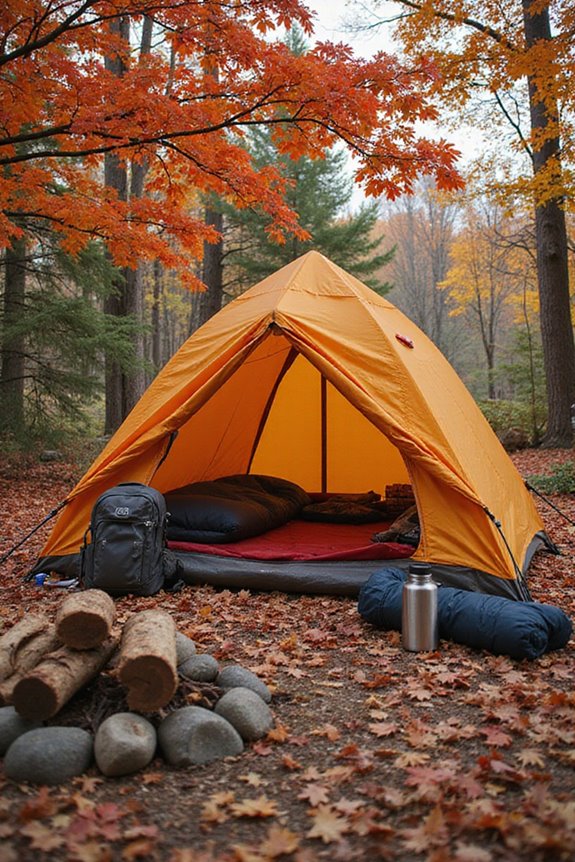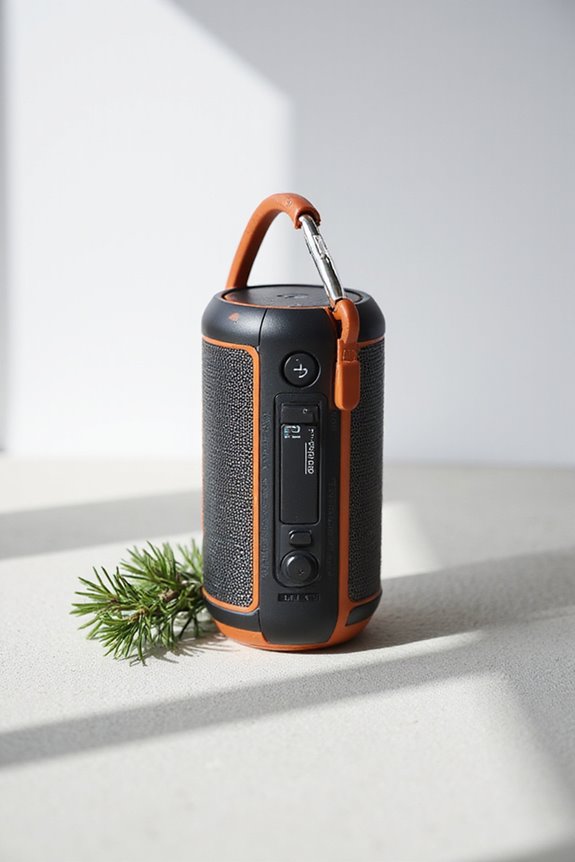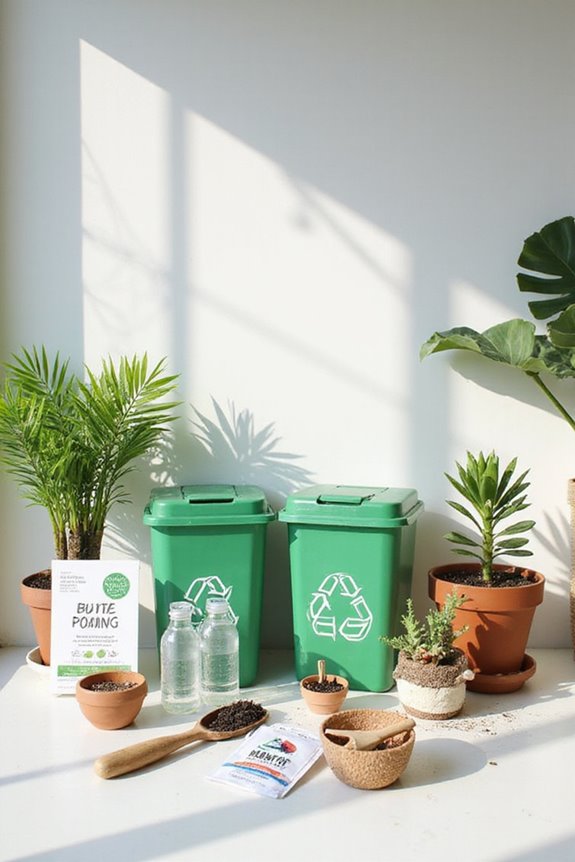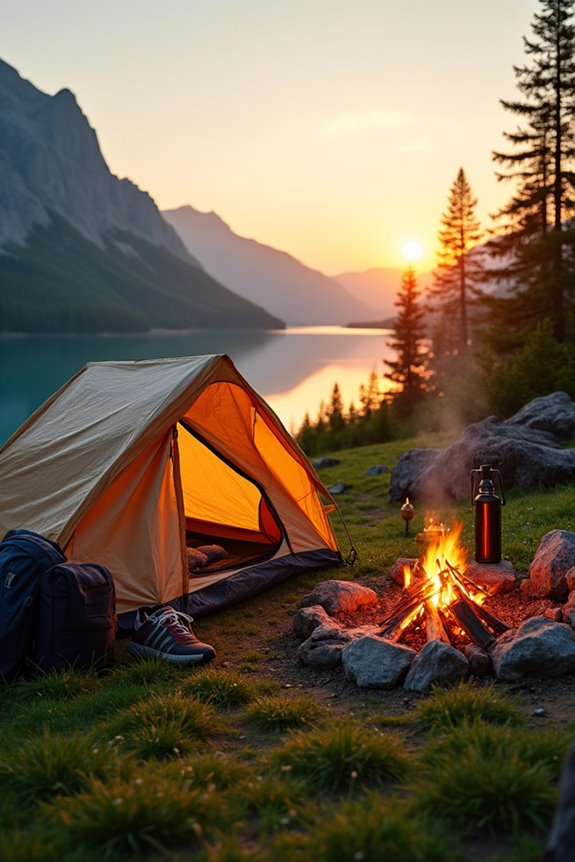Preparing for a fall camping trip means braving the chill with the right layers! Start with warm, moisture-wicking base layers and add a cozy fleece mid-layer. Don’t forget a waterproof jacket—you never know when rain will crash the party. Choose a sturdy tent, ideally on higher ground, and pack hearty meals like chili or stews. And hey, throw in a warm drink to sip by the fire. Want more tips to ace your adventure? There’s plenty ahead!
Key Takeaways
- Pack warm, moisture-wicking base layers, insulating mid-layers, and a waterproof outer layer to combat fall temperatures.
- Select a campsite on higher ground, away from low-lying areas, and prepare for wind and rain with proper shelter.
- Bring sufficient food and water, aiming for hearty meals and at least four liters of water per person daily.
- Carry safety essentials like a first-aid kit, headlamps, and a map or GPS device, and stay aware of wildlife.
- Monitor weather forecasts leading up to your trip and pack extra layers for warmth, along with waterproof gear.
Clothing and Layering Essentials
When gearing up for a fall camping trip, the right clothing can make all the difference between a cozy adventure and an uncomfortable one. Utilizing effective layering techniques is essential; start with warm, moisture-wicking base layers made from materials like merino wool or polyester. Then, add a mid-layer, such as a fleece jacket, for extra warmth. Top it off with a waterproof and wind-resistant outer layer to fend off unpredictable weather. Don’t forget about your feet! Waterproof boots are a must, providing both insulation and traction. Accessories like hats and gloves keep chilly mornings manageable. With the right clothing materials, campers can adapt to temperature changes, stay dry, and enjoy the beauty of the season without worrying about the cold.
Shelter and Campsite Setup
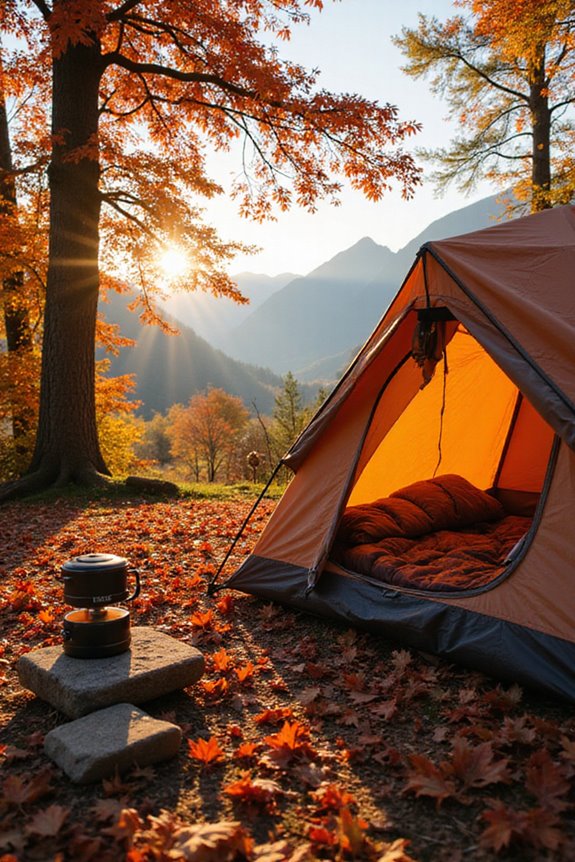
Setting up the perfect campsite can feel like an art form, one that makes the difference between a cozy getaway and a sleep-deprived night under the stars. Choosing the right shelter types, like a conventional tent with a rainfly or an ultralight tarp, is vital. Site selection plays an important role; look for spots sheltered from wind and away from low-lying areas that pool water. Ground protection is key—using a tarp or footprint can help keep moisture at bay, while closed-cell foam pads provide that much-needed insulation. Securing techniques, like using trucker’s hitch knots, guarantee stability. Weatherproofing tips, such as adjusting tarp edges for ventilation, can enhance comfort considerations, making a world of difference when the temperature drops. Additionally, selecting a tent with weather resistance features will ensure you stay dry and comfortable during unexpected rain showers.
Equipment and Essentials to Bring
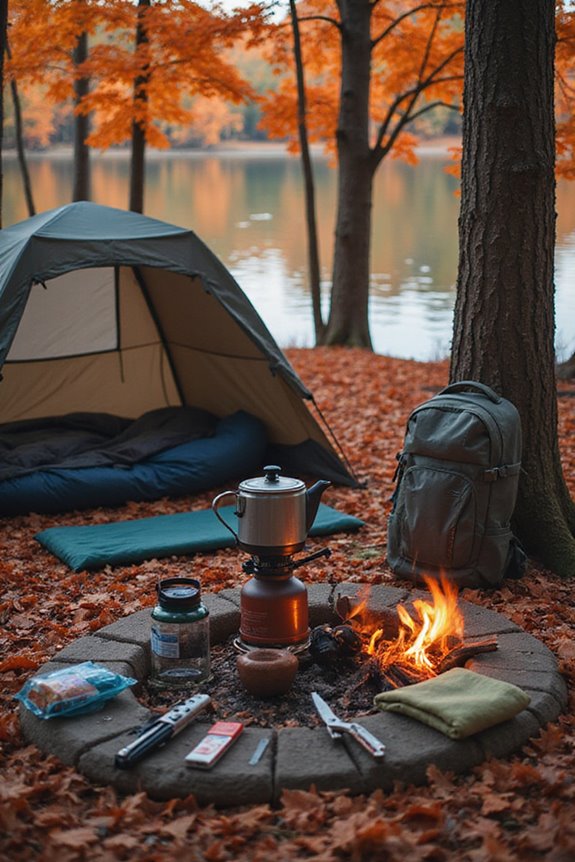
Once the campsite is set up and the shelter is secure, it’s time to think about what to bring along for the adventure. A solid gear checklist is vital for a successful fall camping trip. Essential items include warm base layers, insulating mid-layers, and a wind-resistant outer jacket to face the chilly air. Don’t forget waterproof hiking boots for those muddy trails! For cozy nights, pack an insulated sleeping bag, a comfy sleeping pad, and perhaps a soft camping pillow. Safety is key, so headlamps, a trusty first aid kit, and extra batteries are must-haves. Finally, personal hygiene items like biodegradable soap and trash bags keep the campsite clean and pleasant. Additionally, consider bringing a waterproof rating of at least PU1000mm for your tent to ensure reliable rain protection. With these essentials, the adventure is primed for joy!
Food, Water, and Hydration Planning

Planning meals and hydration for a fall camping trip can be as exciting as the adventure itself, especially when imagining cozy evenings around the campfire. Meal prepping is key; hearty dishes like stews, chili, or even sweet potato hash with sausage will warm the soul. Pack non-perishable items like beans and rice to simplify cooking while ensuring you have that satisfying meal at the end of a long hike. Hydration tips are essential, too! Aim for at least four liters of water per person each day, and don’t forget to treat water from natural sources. Hot drinks like cocoa or tea can enhance chilly nights, making the experience even more enjoyable. Stay hydrated; your adventure depends on it!
Safety and Comfort Considerations
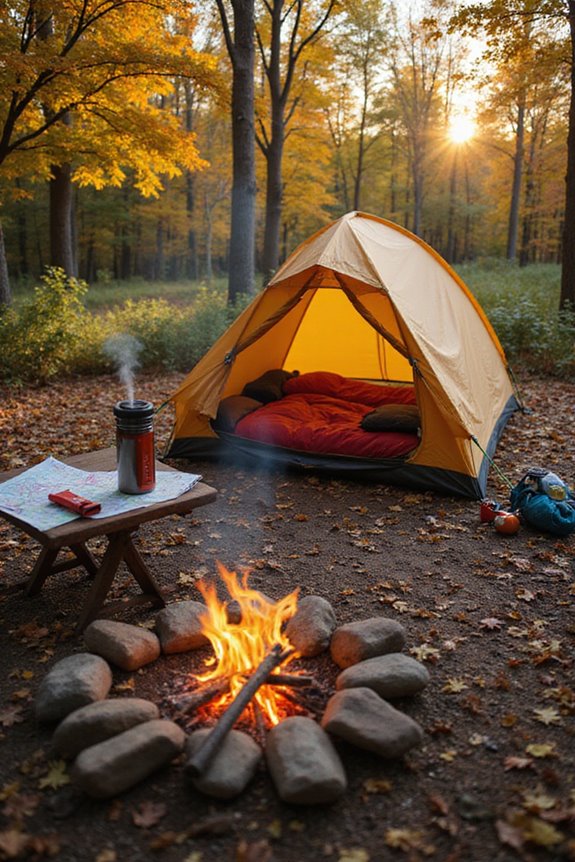
Starting on a fall camping trip requires more than just packing a sleeping bag and a few snacks; it demands a thoughtful approach to safety and comfort that can make or break the experience. First, being aware of wildlife interactions is vital—after all, you don’t want a curious bear raiding your snack stash! Emergency preparedness is fundamental too; carrying a well-stocked first-aid kit and knowing the nearest ranger station can be lifesavers. Layered clothing keeps campers warm, while waterproof gear guarantees comfort in unpredictable weather. Additionally, proper campsite setup—like choosing higher ground and natural windbreaks—enhances safety. Tents with spacious vestibules can provide extra storage for gear, keeping the campsite organized and comfortable. Finally, staying hydrated and keeping the campsite clean prevents health issues, allowing for a delightful, worry-free adventure in the great outdoors.
Researching and Selecting Campsite Locations
How does one find the perfect campsite for a fall adventure? Start by diving into site selection. Research potential locations, keeping an eye on campsite reviews that reveal the hidden gems and the not-so-great spots. Check if the campsite accommodates your group’s size and offers amenities like nearby water sources. Weather forecasts are essential; don’t forget to anticipate those surprise rain showers! Look for sites with level ground to keep your tent from turning into a slanted slide. Consider environmental factors too; balance sun and shade, and pick a spot away from pests and noise. Finally, be sure to book in advance—those prime fall spots can fill up faster than a leaf falling from a tree!
Budgeting for Fall Camping Trips
Why does it seem like every camping trip comes with its own set of financial challenges? Budgeting for fall camping trips doesn’t have to break the bank. Families can start by investing in quality gear—think sturdy tents and comfortable shoes—around $514.50 for a first trip is reasonable. To keep costs down, meal planning tips are golden; prepping meals ahead of time can save a bundle and avoid splurging on pricey takeout. Opt for inexpensive, non-perishable snacks like trail mix and jerky, while considering low-cost activities like fishing to supplement food supplies. Also, don’t forget budget-friendly strategies like borrowing gear or using local firewood. Additionally, investing in a quality waterproof tent can protect your family from unexpected weather and enhance your overall camping experience. With a little creativity, camping can remain an affordable adventure!
Daylight Management and Scheduling Activities
As the sun dips lower in the sky during those brisk fall months, has anyone ever wondered just how to make the most of those dwindling daylight hours? Daylight tracking becomes essential, especially since days shrink noticeably from August to November. Hikers should embrace early mornings, starting at dawn to maximize daylight for longer trails, and always check local sunset planning to avoid scrambling in the dark. It’s wise to set a firm turnaround time on out-and-back routes, ensuring a safe return before nightfall. Cooking meals before sundown is a game-changer too; nothing beats a warm dinner under a glowing sky. And when the stars emerge, don’t forget your headlamp for those late-night tasks—after all, adventure shouldn’t stop when the sun goes down!
Final Preparations Before Departure
Before hitting the road for that much-anticipated fall camping trip, it’s essential to tie up all loose ends to guarantee a smooth adventure. First, consult the weather forecast to pack accordingly; if rain is on the horizon, don’t forget that sturdy tent and extra stakes. A thorough packing list is your best friend here—check off clothes, gear, and food to avoid any last-minute panic. Don’t skimp on warm layers, waterproof gear, and cozy sleeping bags! Also, consider those tasty meals that warm the soul, like hearty soups. Finally, make sure your electronics and clothes are tucked safely in waterproof bags, ready to brave the elements. With everything prepped, the only thing left to do is hit the road and enjoy the great outdoors! Additionally, ensure your tent has high water resistance to stay dry during unexpected downpours.
Frequently Asked Questions
What Wildlife Should I Be Cautious of During Fall Camping?
As autumn leaves crunch beneath weary feet, campers must be vigilant. Bear encounters heighten with seasonal behavior, and deer roam aggressively. Respecting all wildlife, especially large herbivores, guarantees a safer, more harmonious experience in nature’s embrace.
How Can I Keep My Campsite Clean and Eco-Friendly?
To maintain a clean and eco-friendly campsite, one should practice Leave No Trace principles, establish composting tips for organic waste, utilize durable containers, and guarantee proper waste disposal to protect the environment and enhance the camping experience.
What Should I Do in Case of an Emergency While Camping?
In case of an emergency while camping, one should utilize the first aid kit, guarantee emergency contacts are easily accessible, and follow established protocols for communication and evacuation to guarantee safety for all.
Are There Specific Campfire Regulations to Follow in the Fall?
In the forest’s autumn embrace, the flickering flames dance cautiously. Campfire safety becomes paramount, as firewood restrictions whisper of conservation. Adhering to local regulations guarantees the warmth of camaraderie, while nature remains unharmed and serene.
How Can I Entertain Myself During Longer Evenings?
During longer evenings, individuals can engage in campfire stories, sharing ghost tales or personal anecdotes. Evening games like charades or 20 Questions provide interactive fun, fostering connection and laughter among friends and family around the fire.

